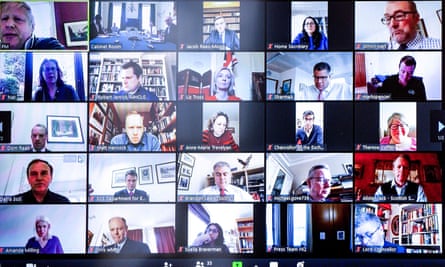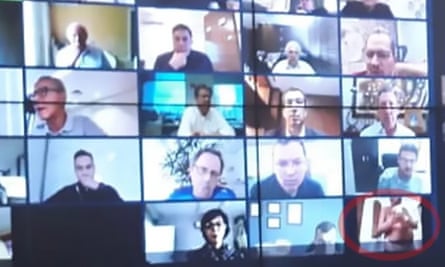On 6 January, a day after the World Heath Organization first reported a strange cluster of pneumonia-like cases in Wuhan, China, a party invitation dropped online. “Mark your calendars”, read the invite sent out by Zoom, a video-conferencing company based in California, “for Zoomtopia 2020!” Innocently enough, Zoom was announcing a real-world get-together for its most ardent clients and fans – at the time, these were mostly customers in enterprise and education, who chose to use Zoom over any number of video-chat competitors because of its easy interface and the relative smoothness of its connections.
The Guardian’s product and service reviews are independent and are in no way influenced by any advertiser or commercial initiative. We will earn a commission from the retailer if you buy something through an affiliate link. Learn more.
But while it was well regarded in tech and business circles (and floated on the US stock exchange in 2019), Zoom was a marginal force in the world in January. This wasn’t Apple. This wasn’t Uber. Guests on their way to Zoomtopia would have to explain to cab drivers and hotel concierges what Zoom was. Then that strange cluster of Wuhan cases began its unstoppable global spread, and by the end of March about half the planet’s governments had locked their citizens indoors, leaving them to figure out how to work and socialise from home. Suddenly, we were all in Zoomtopia.
Worldwide, Zoom saw a thirtyfold increase in usage. In the UK, according to recent Ofcom figures, its 650,000 users in January were up to 13 million by April. With startling rapidity we learned to take meetings with colleagues over Zoom, and afterwards take tea with Mum. When we think back on the age of coronavirus, it will be with feelings of grief, foremost, and not a little political fury. But I’m sure that some memories of this strange and sad period will be coloured by the aesthetics and quirks of the video chat. All those pixelated 2D faces. The joke-crushing audio delays. In-conversation nervousness about Zoom’s unimpressive record on security and the company’s potential misuse of data (Zoom apologised for having sent data to Facebook without the permission of users). Post-conversation cringes about having to stiffly wave goodbye, to cover those dreadful hanging seconds between pressing to leave a meeting and actually going.
The other day, I even had a Zoom-formatted dream – a recurring one in which I’m best friends with the entire Tottenham Hotspur first team, only this time the boys had come to consult me for tactical and spiritual advice via the grainy squares of gallery view. We have learned to celebrate and commiserate, propose and divorce, adopt children and dogs, keep therapy appointments, keep fit, date people, dump people, pray – all of this remotely, and while squinting into a low-angled webcam. And if the pace of change has felt a touch brisk for the average user (Zoom moving from irrelevance in most of our lives last winter to a lockdown crutch as necessary as alcohol or Netflix), then the pace of change as felt inside the company has been knockout fast. Thrilling at times, I was told by a company insider called Magnus Falk, but unnerving as well.
Zoom was built for businesses. Suddenly we saw customers using it to host a religious meeting, or a quiz night
Falk, who is British and an adviser to Zoom’s chief information officer, Harry Moseley, first noticed something was up in February when shares in the company suddenly jumped by 10%. “What’s going on?” he texted Moseley, who replied: “There’s a pandemic coming.” Until that moment, Falk admitted, he was among those inside Zoom HQ who “hadn’t connected the dots”. Derek Pando, who works from the company’s California office to cultivate customers abroad, started to notice unprecedented usage in south-east Asia, with the numbers spiking in tandem with headlines about where the virus was heading: China, the Philippines, Thailand, Italy, and wider in Europe. “Countries we hadn’t been popular in,” Pando says, “or hadn’t had a presence in, or who spoke languages we didn’t support yet. All of a sudden, there was a massive amount of use.”
Phil Perry, the head of Zoom’s UK office, had only just established the British arm of the company when the virus hit Europe. According to Ofcom, a quarter of the UK population has tried Zoom at least once during lockdown. The cast of EastEnders came together on the platform for a charity quiz, while the cast of Derry Girls used it to rehearse lines ahead of shooting their third series. When the Welsh assembly met over Zoom, a minister forgot to switch off his microphone before swearing about a colleague. British Vogue orchestrated a socially distanced fashion shoot: stylist in one city, models in another, the dresses courtesy of Fendi and Valentino, and the communications via a bunch of laptops.

“We’ve been delighted and humbled, and are proud in terms of how people have used the platform,” Perry says, pointing out, however, that all this came with new pressures. Pando says the same. He has worked at Zoom since it was “super-below-the-radar”, when people’s eyes glazed over at any mention of video conferencing. Now Pando’s mum regularly calls him to say how proud she is of him, as if he were manning the frontlines. “All of a sudden we entered a place on the world stage that we were not used to,” he says. “It was a pressure cooker – increasing users, but also increasing attention now that so much of the world’s economic and social life relies on Zoom.”
Falk found himself advising his 87-year-old father-in-law in East Lothian on how to Zoom a church meeting. He was starting to realise there might be “Oh dear” moments coming, as a tool that was built for work began to be used in more imaginative and personal ways. “Zoom was built for businesses to adopt,” Falk explains, “so most of our customers up to this point had been businesses. Suddenly we saw a whole bunch of users using the freemium version to host a religious meeting, or to have piano lessons, or a quiz night, or choir practice. These were uses that were totally unfamiliar to us.”

The company was no longer below anybody’s radar. “People didn’t used to care whether Eric [Yuan, the CEO] took Zoom this way or that way,” Falk says. “The only thing that mattered was: were the customers happy? Now we go this way or that way, and suddenly large groups have opinions. And will publish those opinions. All of a sudden he became the CEO of a public good [and] everyone felt they owned a little bit of Zoom.”
Nobody wanted to own any of Zoom a decade ago. “Just about everyone in Silicon Valley thought it was a terrible idea and passed… oops,” says Jim Scheinman, a close friend of Yuan, who witnessed the founder’s early struggles. Scheinman’s cousin, Dan Scheinman, an early believer who did sign a cheque and who accompanied Yuan to meetings with other potential investors, has spoken of how they were often hustled away within minutes. At the time, in 2011, the video-conferencing market was seen as overcrowded and stale. Perhaps as importantly, Yuan did not conform to the Mark Zuckerberg ideal of a founder (dear to Silicon Valley’s notion of itself at the time), in that he wasn’t a twentysomething graduate fresh out of Stanford or Harvard. Yuan was an experienced engineer. Born and educated in China, he had the temerity to try to found a Silicon Valley startup at the advanced age of 40.
Yuan (who did not want to be interviewed for this story, citing a desire to “step back from any media activity to focus on the company”) grew up in Shandong, on China’s east coast. He first became interested in the potential of computer-enabled chatter when travelling for hours to visit a girlfriend studying at a distant university. What if they could open some software and talk from their dorms? Most of the big American tech firms had hopes of hitting on a video-conferencing breakthrough that would be taken up by the mass market, but progress was slow and frustrating. A popular joke around Silicon Valley at the time was: what’s the only thing less realistic than the space travel in Star Trek? All that seamless video conferencing. The way the captains can speak, ship to ship, alien tech to alien tech, without any crashes or freezes or seeing endless spinning wheels seemed far-fetched.

Traditionally, when a mega corp or government or army wanted its people to speak face to face over great distances, they established their own closed systems, training and hiring in-house staff to maintain the lines of communication, and in the process spending a fortune. Meanwhile, companies without the same resources relied on more affordable commercial products, becoming familiar with screen freezes, choppy sound, and lost connections. Pando recalls, in his previous job, trying to lead a training session of 100 colleagues around the world. They set up a video conference. It crashed. After half an hour, the session was abandoned, “and I remember calculating, OK, that’s 30 minutes of 100 people’s time, so a week’s worth of work was just lost”.
Yuan had moved to California in the mid-1990s, and wound up working for Cisco as a lead engineer on its video-chat application, WebEx. Jim Scheinman says that, by the later noughties, it was clear to Yuan that WebEx “simply was not good”. At that stage (despite almost two decades of consistent effort by the industry) few of the existing options were good. Skype, once a fashionable brand in online voice calling, had been bought by eBay and then flipped to Microsoft, getting lost in big-corp murk. Microsoft had an alternative in the works, later branding it Microsoft Teams. Google had launched a service called Hangouts, later changing this to Meet. Adobe had something called Connect. AT&T also had a Connect, while IBM was mixing things up with its own offering, Connections. There was also an iMeet, a GoToMeeting, a Vidyo, a LogMeIn.
One day in 2011, Yuan visited his bosses and told them that WebEx was ill-suited to the coming age of iPhones and cloud computing, and that it should be rebuilt with mobile in mind. Falk picks up the story: “Eric went to the Cisco executive board and tried to persuade them to re-engineer the product from the ground up. And the way I’ve heard it, Eric was told: ‘Back to the day job.’”
Instead, he went off and founded a limited company, naming it Saasbee. In mid-2011, Yuan quit Cisco for Saasbee, taking 40 of Cisco’s engineers with him. On the eve of formally launching his new company, Yuan called Jim Scheinman, wondering about its name. Scheinman had been reading his children a book by Thacher Hurd called Zoom City, and suggested Zoom, “because it was easy to say, easy to spell and it could be used as a verb”. Yuan bought the rights to a website, zoom.us, formerly owned by a trader in magical charms. The company grew quickly from there, as though charmed itself.
Zoom signed up universities and hospitals as clients, and became a dependable name in comms in Silicon Valley. According to a story told by an employee called Jim Mercer – he once worked for a rival, GoToMeeting – when Zoom appeared on the scene, competitors started asking each other, “What is this voodoo?” Benedict Evans, an industry analyst, says Zoom’s market gains were the result of gentle and discrete innovations, mostly involving engineering and interface tweaks that made joining a video call frictionless: “You didn’t have to do anything.” Unlike rival offerings, Evans explains, which tended to operate more like phones or social networks, in that you had to have an account to attend, and you had to know exactly who you were trying to communicate with, joining a meeting over Zoom was as simple as tapping a link. “It removed all the little bits of friction that nobody had really noticed before,” Evans says. It also opened itself up to all sorts of security vulnerabilities – but more on that later.
Pando says it’s always been common practice inside Zoom HQ for colleagues to video-meet each other, floor to floor. Though there have been some eye-watering funding rounds during Zoom’s years of expansion (Sequoia, an early backer of Apple, pumped in $100m in 2017), it is part of Yuan’s legend that he rarely went to meet investors in person. He first pushed the use of virtual backgrounds, those artificial images that shimmer behind a Zoom caller to conceal their true location, so that he could attend meetings while watching one of his three children play high-school basketball. Zoom had cycled through advertising slogans from the clunky (“Unified meeting experience!”) to the cloying (“We can see clearly now!”), before it settled on a blunter sell that spoke to Yuan’s one-note philosophy behind the software: “Zoom just works.”
Come lockdown, and enforced dependency on video chat, Zoom found itself the overnight winner in a global popularity contest it hardly knew it had entered. The site just worked a little better already, and in the end that was all it took to capture the zeitgeist.

In terms of meeting minutes clocked, Microsoft still has a larger share of the world’s video-conferencing market than Zoom. Many employers, whether for reasons of taste, or the needs of IT departments, or squeamishness around security, prefer their staff to steer clear of Zoom altogether. That Zoom is now seen as the recognised standard in lockdown communication – the go-to verb – was confirmed when I tried to arrange an interview with a young celebrity over Google Meet. Panicked emails ensued. Google Meet? What kind of cowboy interview was this going to be? Couldn’t we just Zoom? It was as if I’d suggested an interview by post.
Perry says these last few months will lead to changes to office culture in the UK
Many of the world’s new Zoomers have learned (while catching up with grandad, jockeying to be heard in a staff meeting, leading a maths class, pitching for promotion or trying to flirt with a stranger) that all manner of human interactions are possible by video. They are just not very nourishing, not as much fun, and leave you feeling weirdly short-changed, as though the human animal inside is aware it has been tricked.
Perry says these last few months will lead to changes to office culture in the UK, with more companies willing to trust their employees to work from home. “But we’re social animals,” he adds, “and there’s a need for human connection that’s irreplaceable.” I thought of these words one Sunday afternoon, when my entire family gathered for our first meeting of the lockdown. With members ranging in age from three to 92, this was no small technological undertaking. We used Zoom, because by now it was Zoom that everybody was familiar with. Normally we’re a family of great talkers, and everyone fights to get a word in. Gathered in the chequerboard squares of gallery view, we stared into our webcams and waited. There was silence, then my 92-year-old grandmother said, “What do we do now?”
By April, the Star Trek joke had come full circle, with the cast of the TV series using Zoom to stage a big reunion party. A locked-down Jennifer Lopez was shooting scenes for her movie while a co-star Zoomed in lines of dialogue from elsewhere. Meryl Streep popped up on Zoom to sing a Sondheim number in honour of the composer’s birthday. Metallica were elsewhere, in another private Zoom room, composing their next album. To raise funds, low- to mid-level celebrities were selling Zoom conversations by the minute to fans. You could get the original Green Power Ranger for £7 a minute; Lance from ‘NSync for three times that.

These weren’t even the strangest or the saddest things happening on the platform. In Singapore, a criminal’s death sentence was handed down over Zoom. A lecturer at the University of Miami had to resign after sharing his screen with students, betraying evidence of a recent visit to a page entitled “Busty college girl”. A London synagogue’s online service was crashed by racists, one of a number of cases of “Zoom-bombing” in which uninvited guests appeared in meetings to hurl abuse, cause mischief, or spy. “The elemental thing that we sometimes forget about the internet,” Evans says, “is that it’s people. The internet is people. When Zoom got all these millions of new users, they got a lot of arseholes, too. There’s been a lot of scrambling to catch up.”
On 31 March, a locked-down Boris Johnson tweeted about chairing his “first ever digital cabinet”. Incredibly, to almost everyone at home and abroad, the UK government – far from using a closed network to communicate via video – was using a £15.99-a-month Zoom account. Perhaps Johnson’s intent was to paint a picture of a competent prime minister being canny with his embrace of technology. Perhaps he was trying to play the everyman: look, I’m using civvy software, just like the rest of you. In fact, Falk tells me, Johnson’s Twitter message was a “Houston, we’ve got a problem moment… All hell broke loose.”
The UK prime minister had inadvertently publicised information that, in theory, opened up a cabinet meeting to Zoom-bombers. Falk insists the meeting “had been very secure… But it opened the debate. You know how you watch Twitter conversations and they go spiralling off?”
Yuan and his staff had already ridden out a security scandal in the summer of 2019, when an internet researcher called Jonathan Leitschuh discovered it was possible for certain users to be sent a nondescript and innocuous-seeming weblink that, when clicked, would plunge them into a live-and-running video call. Though Zoom released a fix, information-security types were incredulous that such a careless flaw could have crept into such a prominent product. Christina Warren, a tech analyst who hosts a popular podcast (she also works for rival Microsoft), is among those who have felt uneasy about Zoom’s curious combination of “fantastic user experience” with an initial lack of engagement with privacy concerns. Warren was one of the people who questioned Yuan’s rather troubling suggestion, recently, that he’d allow the FBI or local police to spy on a private Zoom call if subpoenaed to. “[So] if you’re doing activism on Zoom,” she wrote, “you might want to reconsider.”

On the spate of Zoom-bombings that were so damaging to the platform’s reputation, Falk holds up his hands: our fault. That outsiders with malicious intent could enter meetings that had “no waiting room, no password… That’s really worrying. Clearly we got it wrong to allow people to do that, or not to have a default [insistence on security]. That kind of exploded. And the only thing we could do was put it right… to recognise that, in our desire to help, we’d got it wrong.”
Announcing a three-month push to improve its security, including the eventual introduction of end-to-end encryption for some calls, Yuan issued a public apology in early April, pointing out that “we did not design the product with the foresight that... every person in the world would suddenly be working, studying and socialising from home”. By May it was clear just how far Yuan and his company had to go in terms of securing its service, when Devon and Cornwall police announced it was investigating the worst case of Zoom-bombing yet: a video-conferenced gym class for children, hacked into with images of abuse.
***
On a sunny day in late June, as lockdown strictures finally began to ease, I woke up, hungover and tired. I’d been up late, playing poker over Zoom. A neighbour in a downstairs flat was working in her garden, a cardboard shield placed over her screen to keep off the glare while she chatted to colleagues on a four-way Zoom call. I was late for a meeting of my own and there wasn’t enough time to clear away the empty bottles. So I rotated the laptop a bit, with my back to a wall, and pressed to join.
As the meeting dragged, using skills that were by now well honed, I kept my neck and head still, and tried not to dart my eyes around the screen, while simultaneously browsing the internet. I read about a seven-day legal battle, brought by Kazakhstan and originally due to be heard in a London courtroom, that was moved to Zoom – the first trial of its kind, with judge, lawyers and Kazakh interpreter patched in from home. The Daily Mail had a report that bookings for chin- and neck-based plastic surgery were up. Three months of staring at ourselves from the opaque, unflattering angle of a tilted webcam had clearly had an effect. A businessman in Brazil had accidentally filmed himself topless, heading off to wash, during a conference with the president, Jair Bolsonaro.
I read the transcript of Zoom’s latest earnings call, in which the achievements in the first quarter of 2020 were spelled out in full. Revenue was up by 169% and Yuan and his team were predicting that, in 2020 as a whole, users would be spending 2tn minutes on the platform. Around 3m years, give or take, and enough time to travel to an alternative solar system. I kept browsing. Zoom was trialling a new catchphrase on its website: “In this together!”, as though to head off those lingering security doubts. And I noticed that Zoomtopia, the meet-up for clients and fans, was back on the calendar, only now it was going to be a video gathering, staged entirely online.

Comments (…)
Sign in or create your Guardian account to join the discussion